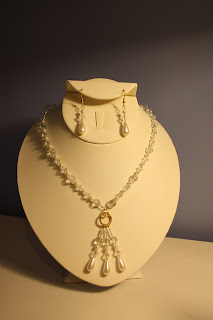Well, this is my very first BLOG. I thought it would be cool and help my process if I documented my journey through the fascinating world of polymer clay. I have been having a love affair with beads now for the last eight years and have made and sold my hand-crafted beaded jewellery at various markets around Melbourne, at retail outlets and via home party plan. Since I moved to Brisbane, the jewellery-making has been more for myself, gifts and special occasions, such as my brother-in-law's wedding last month (Images 1a, 1b).
 |
| Image 1a: Necklace & earrings crafted for my new sister-in-law for her wedding day. |
 |
| Image 1b: Bridesmaids necklaces. |
For my own wedding, three years ago, I had my first experience with polymer clay. I made little polymer clay beads in decor-matching colours and used them to adorn beaded name place keyrings (Image 2). I really enjoyed this medium to work with and have made a few beads since then. All extremely amateur-ish, I had no idea they could be sanded and polished to a natural shine (the ones used in the keyrings had a spray varnish applied to them, which made them a little sticky).
 |
| Image 2: Polymer clay beads on name place keyrings. |
What attracts me to polymer clay is the creative license it gives me, I like to experiment and I like to be different. In the past, I have experimented through using wirework to create different looks in beaded jewellery. My passion for polymer clay bead-making was reignited by a recent trip to Mount Tamborine in the Gold Coast hinterland. At the Gallery Walk there, I came across a little shop called SheBeads. A display of beautiful polymer clay beaded jewellery, with such a professional finish, I was bedazzled. My mother admired them so much and I realised, I could make something like this, if I applied myself. So I have set about "applying" myself and delved into the new playground of polymer clay. And I'm starting to realise just how many new toys I will get to play with in this playground - perhaps I bit off more than I could chew (or afford) in promising my mum one of these gorgeous necklaces...NAH!!
So far, I have made three batches of beads using just the tools I have on-hand. I have a craft board, a wooden dowel as a roller, a couple of craft knives and some Sculpey III clay. My first batch was sloppily formed, heaps of fingerprints and the colours were not pleasing after baking. I wasn't happy with the matt look of the beads after baking so have been reading and reading and reading online forums for clues as to how to finish polymer clay beads to a nice shine. On the weekend, I bought a pasta machine and a rock tumbler and placed an order at Over the Rainbow for some more equipment and some Kato clay. I am determined to get my beads looking professional for my mum's necklace.
At the moment, while I wait for my Over the Rainbow order to arrive, I am experimenting with my rock tumbler using my first three batches of beads. Here are some of the things I have tried:
1. I sewed some calico together at double thickness to make a liner for the rubber barrel of my tumbler. I then cut up 1-inch squares of calico and filled the tumbler to about ¾ full with beads and calico. I tumbled for about 12 hours. The result was a definite shine on the beads, but it was a 'dull' shine (is there such a thing?!), not quite the shine I was hoping for.
2. I used my calico liner, but this time added some river rocks (bought from a home store). These river rocks were quite large compared to those recommended by Desiree (How to Tumble Sand Polymer Clay - river rocks). I filled the tumbler with river rocks to about ½ full then added my beads. I tumbled for 3 hours and found they were not even slightly shiny.
HOWEVER... I thought about it during the night and realised the river rocks were sanding the beads and thus the beads were probably coated with a fine PC dust. I got out a square of calico and buffed one surface of one of the beads and MAGIC shiny!! I did the same with an unsanded bead and it came up shinier but nowhere near as shiny as the river rock-sanded bead (Image 3).
 |
| Image 3: River rock sanded bead (left), unsanded buffed bead (middle), unsanded/unbuffed bead (right). |
Today, I'm going to try to pick up some of the smaller river rocks as used by Desiree. Then I'll try a longer river rock tumbling session (around 6 hours) followed by a buffing calico tumbling session.
I must say from all the reading I've been doing on online forums, polymer clay work seems to be a real passion for many people and I can see why! The polymer clay bug has snared yet another victim.
The Noob Beader